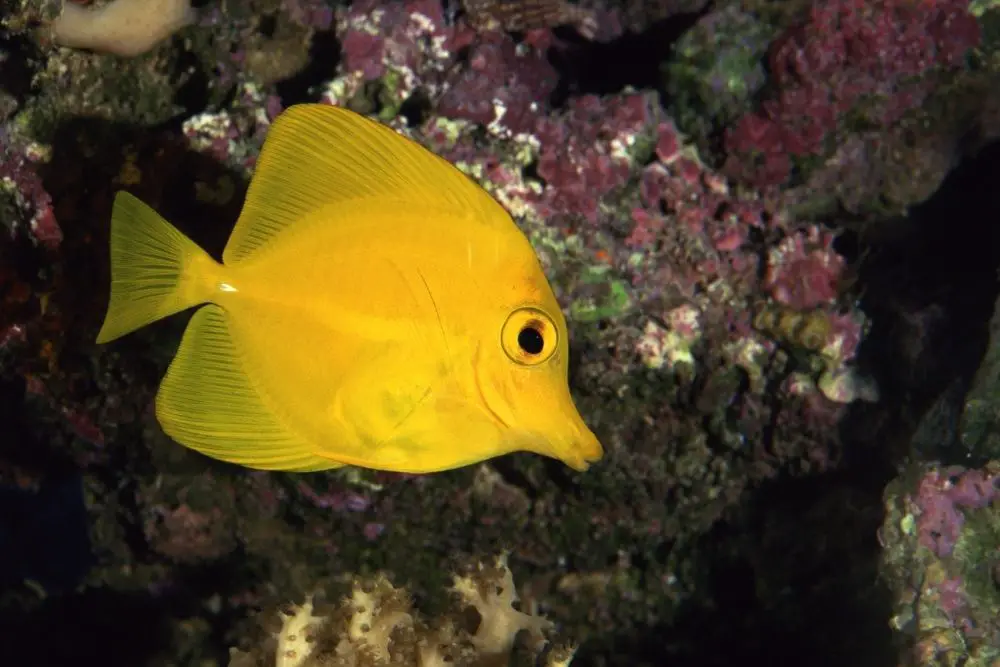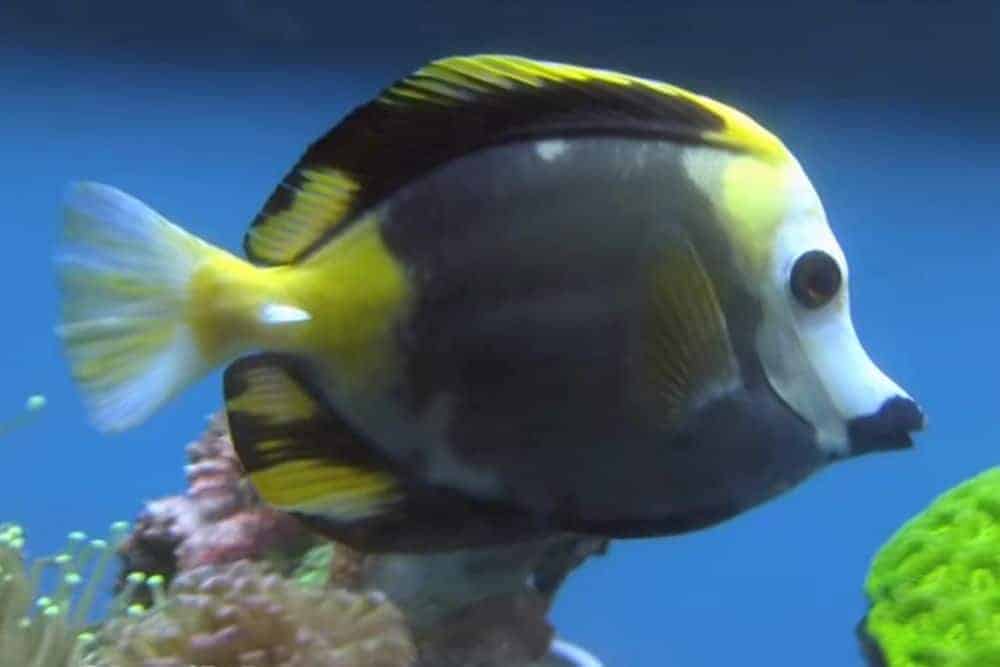Tang species are not made out of mold nor different individuals of the same species act identically; all have their own predilection for getting along, adapting to captivity. Some species (e.g. Acanthurus Sohal, A. Lineatus, A. Olivaceus…) are notorious for being super-alpha animals, but even the lowliest Yellow Tang can become a terror.
Choosing the best tang for your aquarium

Picking out good Tang specimens involves a multi-prong approach.
Don’t buy just-arrived fishes. LEAVE them at your dealers for a few days to a week.
To ensure they will live, they are eating captive foods.
To give them time to show whether they have been sufficiently cleansed of external parasites by your dealer (do this yourself if there is any doubt), particularly Crypt and Flukes. I have never encountered a wild-caught (all are present, though efforts are afoot for producing captive specimens) tang that did not have these.
Look for damage to the mouth. Frayed fins, minor body markings are not a problem; indeed, they are to be expected; injury to the mouth, however, can be colossal trouble; resulting in cessation of feeding and death.

What Size Yellow tang Should I Get?
Like Goldilocks and porridge temperature, you want to buy your Yellow Tangs at the right size: Not too large (as in half of maximum size plus) nor too small (under 2-3 inches overall for most species), but “medium” is about right. Too big and tiny specimens get too damaged in the collection, handling, and shipping, and adapt poorly to captive conditions.
Evidence of neuromast destruction (Head And Lateral Line Erosion) does not qualify a purchase for me; as long as the pitting, whiting around the lateral line pores isn’t too deep, extensive all will heal with good water quality and nutrition in time.
API STRESS COAT Aquarium Water Conditioner 16-Ounce Bottle
Tetra AquaSafe Plus, 8.45 Ounces, aquarium Water Conditioner And Dechlorinator, Model Number: 46798162681
$10.19 (as of December 16, 2025 09:02 GMT +03:00 - More infoProduct prices and availability are accurate as of the date/time indicated and are subject to change. Any price and availability information displayed on [relevant Amazon Site(s), as applicable] at the time of purchase will apply to the purchase of this product.)API TAP WATER CONDITIONER Aquarium Water Conditioner 16-Ounce Bottle
$8.48 (as of December 16, 2025 09:02 GMT +03:00 - More infoProduct prices and availability are accurate as of the date/time indicated and are subject to change. Any price and availability information displayed on [relevant Amazon Site(s), as applicable] at the time of purchase will apply to the purchase of this product.)If you’re a new hobbyist, choose of the hardier species of Tangs to try (e.g., bristletooth, Zebrasoma, some Acanthurus); and avoid the opposite end of the spectrum (Powder Browns, Blues, Achilles); as all Tangs are “ich magnets”; some much more so than others.
Avoid the “too mean” ones (Sohal, Orange Shoulder, Pyjama) unless you have an extensive reef or marine tank and much experience.
Avoid too-thin specimens; ones with pinched and bumpy bellies are fine, but being skinny in the flanks and head are out.
Intelligently stock your Tangs (and other livestock) in a systematic order, the less aggressive first, most aggressive last.

Only buy Surgeonfishes when you presently have a system and spare room for them at the likely maximum size they’ll grow to be. The road to Heck is paved with good intentions, and way too many Tangs have lived short, miserable, harassed lives by being placed in too small and overcrowded, mis-stocked settings by folks who planned on upgrading. Buy them after you’ve got that new set up – not before.
As gone over in the Disease/Health section below, all Tangs should be isolated, quarantined for a week or two to give them time to rest up, you the opportunity to observe them for disease issues, ahead of introduction.
Additionally, I strongly advise the use of pH-adjusted freshwater dips/baths, with formalin if convenient or you’re processing many pieces (as in if you’re in the trade) to “knock off” a good deal of the external parasite load of newly acquired Acanthurids ahead of their introduction to main/display systems or shipping them on through the chain of custody in the industry.
As far as when to stock Tangs, due to their territoriality and penchant for algal searching/consumption, they are best placed as last or near-last fish specimens; in well-aged systems that have been up and running for at least a few months’ time.

What should be the yellow tang tank size?
For their size, Yellow tangs require a goodly amount of space, both to swim about and exercise in, but to feel comfortable mentally-emotionally. Limited space and/or crowded Tang is not a happy Tang.
Even the smallest Ctenochaetus and Acanthurus species need a four-foot-long system minimally; larger Acanthurus, Zebrasoma, and all Nasos an absolute minimum of six-foot runs. Jamming these animals into too-small confines or with too much other biota results in aberrant and overtly agonistic behavior, and their early demise; don’t do it.
Increasing usable space via an arrangement of rock, corals, et al. is essential. Rather than a giant wall taking up space, it’s far better to have breaks/gaps in the hardscape with these fishes, ideally, actually free-standing bommies that serve to break up the physical environment while providing visual barriers.
Though Yellow Tangs are fast and skillful swimmers, they have at times been known to get sucked onto strong pump intakes; for all’s sake, such points of entry should be screened, their suctions diffused to prevent such damage. Hiding powerful suctions behind rock work is one useful way to accomplish this; another is applying large open cell sponge material and oversized screens.
Surgeonfishes don’t mind overly bright settings but do require very brisk water movement and the high dissolved oxygen that is resultant. Strictly speaking, their environments cannot be over-circulated with tens of times turn over per hour appreciated.
There are a few celebrated groups/families of fishes that are susceptible to the vagaries of “metabolite poisoning,”; including Acanthurids.
Excessive waste build-up through over and misfeeding, poor skimming, over-crowding… often results in the neuromast destruction syndrome labeled “Hole in the Head,” or Head and Lateral Line Erosion (the contraction: HLLE) in these fishes. But know here that this “syndrome” is principally either lack of endogenous (internal) vitamin caused and/or external filth (in their water) related. Keep all ammonia and nitrite at zero, and nitrates below ten ppm in their systems.

Hi, my name is Sean, and I’m the primary writer on the site. I’m blogging mostly about freshwater and saltwater aquariums, fish, invertebrates, and plants. I’m experienced in the fishkeeping hobby for many years. Over the years I have kept many tanks, and have recently begun getting more serious in wanting to become a professional aquarist. All my knowledge comes from experience and reading forums and a lot of informative sites. In pursuit of becoming a professional, I also want to inspire as many people as I can to pick up this hobby and keep the public interest growing.
Read more about Sean.
Please join also my Facebook group.




















